Dr Vino's wine blog
wine talk that goes down easy
Mafia-free wine, White House, Justice Roberts, wine service – sipped and spit
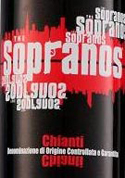 SPIT: Bada-bing!
SPIT: Bada-bing!
Sustainable wine? Organic wine? Been there, drank that. Now: Mafia-free wine! The Sicilian label, Libra Terra, will guarantee that pasta, olive oil and wine will have the “taste of freedom.” [Global Post]
SIPPED: American wine
The White House continues pouring only American wines, so far from four states at official events. The first state dinner is coming up next month–stay tuned for what the Obamas pick for Prime Minister Manmohan Singh! [Obamafoodarama]
SPIT: American wine; SIPPED: generosity
While dining in lower Manhattan last weekend, Chief Justice John Roberts and his wife Jane sipped a bottle of Villa Mangiacane, a Chianti. When they finished their meal, they offered the rest of the wine to a neighboring table, specifically, Gay Talese who blogged about it for City Room.
SIPPED: wine service tips
A budding restaurateur offers his first 50 service tips for his staff, including several wine related ones including “For red wine, ask if the guests want to pour their own or prefer the waiter to pour.” [You’re the Boss, NYT]
SPIT: old vines; SIPPED: apartment complex
Philip White, a wine writer in Australia, has a scathing critique of Constellation, one of the world’s largest wine makers and marketers, and their apparent plans to scale back in Australia. Particularly irksome to him was the uprooting of John Reynell’s 161-year-old vines at Reynella; 41 “tiny apartments” will replace the vines. [INDAILY]
Liquid Memory by Jonathan Nossiter – reviews
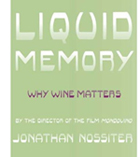 Jonathan Nossiter’s new book, Liquid Memory: Why Wine Matters, has gotten two major reviews in the first two weeks since publication. One was lukewarm. The other was a kick in the solar plexus.
Jonathan Nossiter’s new book, Liquid Memory: Why Wine Matters, has gotten two major reviews in the first two weeks since publication. One was lukewarm. The other was a kick in the solar plexus.
Even though its themes were widely discussed in the wine world, audiences did not flock to see Nossiter’s 2004 documentary, Mondovino, which racked up only $200,000 in box office gross according to IMDB. (Sideways was north of $100 million, by contrast.) I found Mondovino to be shaky, not stirring.
The first review of Liquid Memory came in the NYT Book Review, written by Jim Holt (who is credited as “writing a book about the puzzle of existence”). He offered this warm beer as criticism: “Nossiter didn’t completely win me over.” Despite this, the book soared on Amazon’s sales rankings.
Now get a hold of Mike Steinberger’s review, just published on Slate.com. He writes that the ”solipsism, self-regard, and preening” on display in the book would make the subtitle “Why I Matter” more apt. He also catches Nossiter displaying faux populism both in Nossiter’s lexicon for talking about wine that (literature) as well as the high prices of the wines that Nossiter recommends (Roumier, Roulot, and Dominique Lafon). And he accuses Nossiter of fighting yesterday’s battles.
A great line line from the review summarizes Nossiter’s regrettable tendency to paint his villains with a partisan brush: “The wine world is certainly no Eden, but at least among the grape nuts I know, there seems to be a tacit understanding that politics should end at the rim of the glass—that arguments over wine are spirited enough without injecting politics into the discussion.”
Halloween candy: impossible food-wine pairing?!?
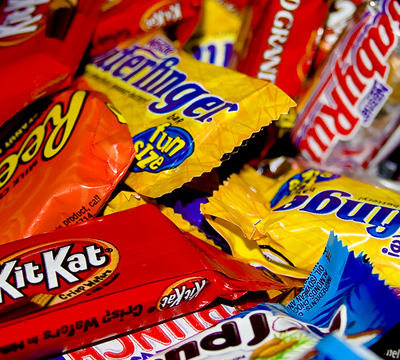
Halloween is a mere two days away and excitement is building around the Dr. Vino World Headquarters: for the kids, they’re after the candy; for me, I can’t wait to take down all the skeletons, ghosts and goblin decorations.
As candy washes over the country these days in a giant, wrapper-encrusted wave, it seems only timely: which wine goes with Halloween candy? Or is it impossible?!?
Please make your candy suggestions as trashy as possible–no gourmet chocolates here, just Reese’s peanut butter cups, KitKats, Almond Joy, Butterfinger, Pop Rocks and/or Necco wafers.
For those of you who cannot fathom pairing candy and wine, then play sommelier for Paul Rudnick: as profiled in yesterday’s NYT, the 51 year old man weighs 150 pounds and subsist almost entirely on candy.
Rocks for shocks: geologists don’t “debunk” terroir; minerality questioned
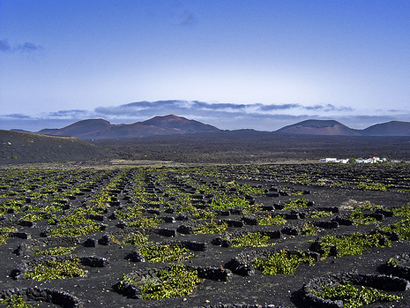
Many geologists object to two things: misusing “minerality” and being misquoted.
Site reader and distributor Damien Casten sent in an AP story (with no byline) yesterday entitled “Geologists debunk soil impact on wine at Ore. talk.” The Oregon event was a special session at the annual conference of the Geological Society of America.
At the meeting, Alex Maltman presented a paper with this to say about minerality: “The widely cited direct, literal connection between vineyard geology and wine taste seems scientifically impossible. Whatever “minerality†in wine is, it is not the taste of vineyard minerals.” He calls any perceived connection a “romantic myth.”
Fair enough, there may not be a transfer of minerals from substrate to the glass, but is terroir debunked? Not quite, argued Jonathan Swinchatt in a paper that cites the indirect influences of drainage, accessibility to water, microbiology, soil temperature, and trace element chemistry. He argued that unraveling these links is “devilishly” complex and thus “the connections between geology and wine will remain elusive for some time to come.”
Terroir: clear as mud!
After the jump, Greg Jones, a climatologist from Southern Oregon University (and son of the founder of Abacela Vineyards and Winery in Roseburg, OR) chimes in with his thoughts from the conference and the reporting of it. Read more…
Shattered Myths – from the Gourmet archive
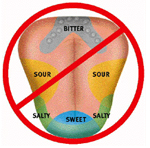 A great piece of wine writing has just become accessible: oddly, with the closing of Gourmet magazine, Gourmet.com has made the classic article “Shattered Myths” available for free.
A great piece of wine writing has just become accessible: oddly, with the closing of Gourmet magazine, Gourmet.com has made the classic article “Shattered Myths” available for free.
Written by NPR contributor Daniel Zwerdling back in 2004, the story starts at a tasting with Riedel stemware, which the attendees loved and bought $1,000 worth of the crystal afterward. Then the author reviews some scientific studies about taste and olfactory analysis of wine in different vessels, which clashed with the what he had seen at the Riedel demonstration. So the author put the question to Georg Riedel. Click through to see Riedel’s reply.
The article then turns to a fascinating and important discussion about perceptions and wine, much of which we have discussed since 2004 in various ways here and elsewhere. The now-available article is an oldie but a goodie and well worth the read if you haven’t already seen it.
Related: “Shattered Myths” [Gourmet]
“Varietal stemware: genius or hucksterism?”
“The Tongue Map: Tasteless Myth Debunked” [LiveScience]
“Wine’s Pleasures: Are They All in Your Head?†[NYT]
Amazon stops selling wine before it ever starts; Wine blogs on Forbes.com
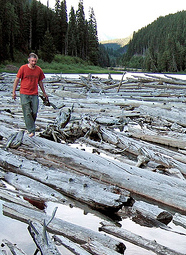 Back in March 2008, when word leaked out about Amazon’s possibly selling wine, Mike Steinberger asked, hopefully, whether Amazon.com could end the war over direct wine deliveries. He continued: “the entry of the Internet retailing colossus into the business seemed just the thing to finally break the logjam over interstate wine shipping.”
Back in March 2008, when word leaked out about Amazon’s possibly selling wine, Mike Steinberger asked, hopefully, whether Amazon.com could end the war over direct wine deliveries. He continued: “the entry of the Internet retailing colossus into the business seemed just the thing to finally break the logjam over interstate wine shipping.”
Instead, the logjam crushed Amazon (AMZN). Late Friday, winebusiness.com ran a story that Amazon was putting its wine retailing business on hold, citing correspondence between amazon and wineries. I contacted members of the AmazonWine team for comment and they were either away on vacation reply or said that they could not comment. The Wall Street Journal got through to a spokesman who confirmed the wine trial was over.
The intractable logjam was the interstate shipping laws that govern interstate wine shipping. You can get 200 pages or so on it in my book Wine Politics: How Governments, Environmentalists, Mobsters, and Critics Influence the Wines We Drink. Or you can check out Tom Wark’s post for a more concise background on the logjam known as the three-tier system. Further, California law on unlicensed “third parties” may have affected the group’s plans.
I look forward to the final analysis of how exactly Amazon attempted to achieve a different structuring of interstate wine retail and why, sadly, it flopped. While AmazonWine kept program was kept under wraps, conventional wisdom is already blaming the bankruptcy of New Vine Logistics, which put the domestic wine component in jeopardy (imported wines were also to be available).
Given the economics of shipping wine, the company may have been targeting higher-priced bottles. In that regard, the economic backdrop didn’t help the plan as high-end wine sales have softened in the past year even though overall consumption of (lower-priced) wine is slightly higher.
![]() In other news, Forbes.com ran a piece late Friday piece entitled, “Must-read wine blogs.” It’s a must-read itself and will give you some tips on some more blogs to add to your feed reader, if those good ones mentioned are not in yours already.
In other news, Forbes.com ran a piece late Friday piece entitled, “Must-read wine blogs.” It’s a must-read itself and will give you some tips on some more blogs to add to your feed reader, if those good ones mentioned are not in yours already.
Charles Heidsieck wants to burst your bubble – decanting Champagne
The flute has been the glass of choice for champagne enthusiasts for decades. If the folks at Champagne house Charles Heidsieck have their way, the flute’s days are numbered.
In New York on Wednesday, they poured their entry-level, Brut NV in both a classic flute as well as a white wine glass. The aromas in the wine glass were much richer in large part because you can actually stick your nose in a wine glass, which is not the case with a flute.
“The Champagnois have communicated around the bubbles, not the wine,” said a spokesman.
The flute accentuates the bubbles coming off the bottom because of a “poil mousse,” or a roughened “scratch point,” said Maxmilian Riedel, also on hand for the event. Regular wine glasses do not have a scratch point, thus any bead tends to be a bit willy nilly, if even present at all. (See the scintillating 15-second video above for comparison of the bubbles!)
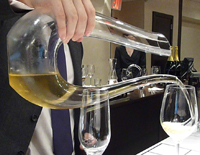 The thrust of the presentation, however, was the unveiling of a “uniquely designed decanter” by Riedel for Charles Heidsieck. The “organic lyre ‘U’ shape” is handmade and mouth-blown and bears a striking resemblance to the “Amadeo” Riedel decanter with a Charles Heidsieck badge. A bottle of the Charles Heidsieck Blanc des Millenaires 1995, a lovely wine, comes with the decanter in a presentation box for $600.
The thrust of the presentation, however, was the unveiling of a “uniquely designed decanter” by Riedel for Charles Heidsieck. The “organic lyre ‘U’ shape” is handmade and mouth-blown and bears a striking resemblance to the “Amadeo” Riedel decanter with a Charles Heidsieck badge. A bottle of the Charles Heidsieck Blanc des Millenaires 1995, a lovely wine, comes with the decanter in a presentation box for $600.
“I think there’s nothing better than aged Champagne,” Riedel said. “And that’s what happens in the decanter. I decant to enrich the wine, not to lose the bubbles.”
Are you going to throw out your flutes and start serving your Champagne in white wine glasses? Or from a lyre-shaped decanter?
White wine, red wine, the frontal cortex, spooky store – sipped and spit
SIPT: white wine
White wine has not ridden the good-for-you train as far, fast or as well as red wine. Yesterday, white wine almost suffered derailment. First, German researchers said that the higher acidity in white wine could damage teeth! (Vigonier begs to differ.) Then, another study of suggested that of all alcoholic drinks, white wine had the biggest impact on women’s fertility in IVF. The Worldwide White Wine Council will issue a new statement shortly.
SPIT: Iron and SIPPED: tannins
Tannins have always gotten the bad rap for mucking up red wine pairings with fish. But it turns out that it’s actually the iron! Read Ray Isle’s funny take on the research.
SPIT: the frontal cortex
“we shouldn’t expect our poor olfactory cortex to be able to reliably assign an exact point score…” [Scienceblogs]
SIPPED: Spooky decorations
TheSnarkHunter points us to this seasonal wine shop display at Biondivino in San Francisco; if you know of other good ones, hit the comments!



